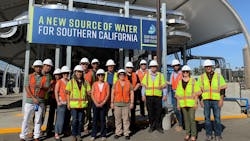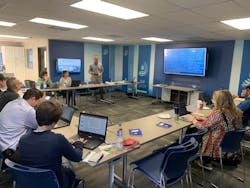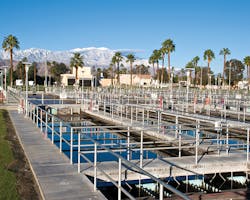AWWA program offers guidance, recognition for wastewater utilities
As the cost and energy required to treat wastewater for discharge into the environment or reuse continues to rise, many treatment plants are looking for ways to become more efficient in their operations. The American Water Works Association (AWWA) has been helping drinking water treatment plants become more efficient for over 20 years through its Partnership for Safe Water program. On the wastewater side, the Partnership for Clean Water, established in 2016, seeks to do the same by providing resources, networking opportunities, and training to participating utilities and municipalities.
“[These programs] have been around for many years and they’re basically dedicated to the process of continuous improvement,” Todd Brewer, senior manager of partnership programs for AWWA, said. “So not just complying but going above and beyond and doing the best that we can for protecting public health and the environment.”
This includes seeking processes that provide “the best overall quality effluent, lowest impact on the environment, and ideally looking quite a bit at energy usage,” Brewer added.
While the current program is designed for traditional wastewater treatment, programs designed to assist reuse facilities will be offered in the future.
“It’s similar to a continuous improvement process that we would use in everyday life. If anybody’s ever taught a teenager how to drive, they were identifying things that needed improvement — and in a hurry,” Brewer said. “And so, you identify the strengths. You also identify areas for improvement and those translate into an action plan. From there, we realize what we need to be better at. What are we going to do about it? And so, there’s guidance across operational considerations. So, it’s kind of a top to bottom look at, are we really supporting the best version of ourselves? Where can we do better?”
Past participants in the program looked at issues including biological oxygen demand (BOD) removal or total suspended solids (TSS) levels, improving operator training to align with state and federal requirements, utility staffing, and funding for capital improvements. One of the biggest focus areas for Partnership organizers is in the area of energy efficiency, according to Brewer, who identified utility energy management as the largest area for improvement across treatment plants overall.
“There are really two general classifications that we look at [in terms of energy efficiency]. One is process energy, or energy related to how much wastewater you’re treating,” Brewer said. “The more wastewater you treat, the more energy you use. And then there’s a base load. All of the buildings that house staff that need to be heated, lighting, things of that nature. [These energy costs are] not related to how much wastewater you’re using, it’s just the cost of doing business, so to speak, but they factor [in].”
Each phase of the Partnership for Clean Water program looks at all aspects of a treatment plant’s performance for areas that can be improved. These phases include:
• Phase I – Commitment
• Phase II – Baseline Data Collection
• Phase III – Self-Assessment
A fourth phase is still being developed and is designed to continue to recognize a treatment plant’s participation in the program after completion of the first three phases.
Phase I: Commitment
Phase I of participation in the Partnership for Clean Water program requires that a utility commit to “the Partnership’s optimization philosophy and to complete the program through Phase III.” In Phase I, utilities complete a membership application and pay a subscription fee based on the size of the population served.
Phase II: Baseline Data Collection
In Phase II, a performance baseline is established. Wastewater treatment plants are required to submit 12 months of effluent quality performance data to AWWA using provided software. Later, data are submitted on an annual basis for as long as the utility participates in the Partnership. This data will later be used by AWWA to show the long-term effects of optimization efforts on effluent quality.
Phase III: Self-Assessment
A comprehensive self-assessment of plant performance and operations is completed in Phase III. Again, the Partnership provides a framework for completing this phase, including a self-assessment guide, report template, and materials checklist. Results from the self-assessment are summarized in a completion report, which is peer-reviewed by utility optimization experts.
In July 2019, the Coachella Valley Water District (CVWD), a public agency that serves approximately 108,000 residential and business customers across 1,000 square miles in Riverside County and in portions of Imperial and San Diego counties, completed the three phases of the program. CVWD received a Directors Award from the Partnership for its report on the district’s largest wastewater treatment plant. It was the first plant in California to achieve this status.
“CVWD is taking a good look at all of their energy usage and they’ve identified the potential for up to 40 percent in energy savings,” Brewer said. “Some of that’s been realized because they’ve implemented some of the things that they’ve identified as opportunities for improvement [through participation in the Partnership]; others are on their plan over a course of years because they require some more capital investment. But 40 percent on energy savings is a pretty big number and should get some folks’ attention.”
Following the Director’s Award announcement, Jim Barrett, CVWD general manager said the award would “help prioritize and guide our future projects at the plant.” WW
Editor’s note: The interview featured in this article was conducted at AWWA’s California-Nevada Section 2019 Fall Conference. CA-NV AWWA’s Spring Conference will be held April 6-9, 2020, at the Disneyland Hotel in Anaheim, Calif. Learn more at www.ca-nv-awwa.org.
About the Author

Alanna Maya
Chief Editor
Alanna Maya is a San Diego State University graduate with more than 15 years of experience writing and editing for national publications. She was Chief Editor for WaterWorld magazine, overseeing editorial, web and video content for the flagship publication of Endeavor's Water Group. In addition, she was responsible for Stormwater magazine and the StormCon conference.


